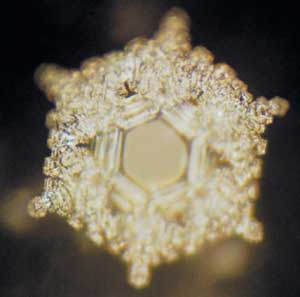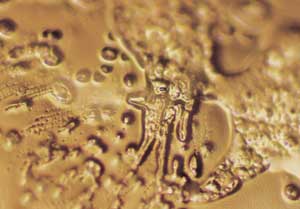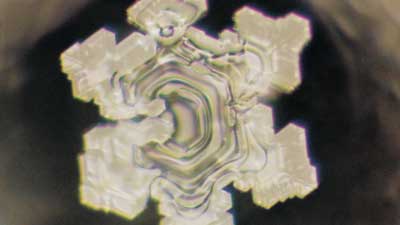Water Crystals
Jan 27, 2007, 1:17a - Science
Science is the most arrogant and the most humble of suitors. Endowed with the audacity to seek Truth yet the humility to prove only falsity, it seeks knowledge as its ultimate goal. Its right has been handcuffed by its left, and together the pair lurch through the world, disposing of the old and selecting of the new. The trail behind yields to the blood of the blasphemous, and the path ahead lays fraught with controversy and consequence.
We often believe that we know, when what we really know is belief.
For the past couple of days I've been investigating phenomena that linger outside the stream of main science. I've heard too many anecdotes of bizarre events that I've felt compelled to investigate them on my own. Over the next several weeks, I plan to post a series of articles reporting on my research into these phenomena. I'll cover many topics, including "beaming" good thoughts to plants, the effects of meditation on crime, and the "memory of water". This first article will investigate the creation of "water crystals".
Justin R first told me about the water crystal experiments several months ago. Basically, it goes something like this.
In 1999, a small group in Japan, led by Masaru Emoto, began photographing the ice crystals formed as freezing water warmed under a microscope. According to his published books, the shape of the crystals depended on the words or photographs shown to the water. They also played different music to the water, and allegedly observed other crystal shapes as a result. In addition, they found that praying and chanting also affected the water crystals. Finally, the source of the water also made a difference to the resulting shape. Here are some examples:

"Love and Gratitude"

"You make me sick"

Mozart symphony
These photographs are astonishing and beautiful as works of art.
However, it is presumptuous to believe that their shapes are somehow influenced by the words, photographs, music, and prayer presented to them. Here's why.
Emoto's process for creating and selecting crystals is neither rigorous nor unbiased. Crystals are created in the following way. First, a lab technician takes a water sample and taps it in its bottle. This appears to be critical to the crystal formation process, as it probably allows sediment that has settled to the bottom of the bottle to be mixed with the rest of the water. Imperfections in water are believed to be critical to ice formation. Second, the technician takes 50 samples from the bottle and places them as drops on petri dishes, which are then stored in a freezer at -25° C. After 3 hours, the technician removes the dishes from the freezer and places them under a microscope. The room is set to -5° C, and as the water warms, it forms ice crystals, which are photographed under the microscope with a high-speed camera. (1)
Throughout this process, there are opportunities for bias. First, the experiments are not "blind", so the technicians know what stimulus has been presented to each sample of water. This may cause them to photograph the water crystals at certain points in time or from certain angles, or to seek out and only photograph those crystals which look a specific way. For example, if they know that the water has been presented with the word "Peace", they may choose to only photograph crystals that are beautiful, symetric, and free from blemish. Second, of the 50 samples that are taken, only a small number (unspecified) actually form into crystals. (1) Why the others don't form crystals even though they're presented with the same stimulus is unclear and further weakens Emoto's theory.
Third, Emoto himself admits that the process of selecting which photographs to publish is not scientific. He says that no 2 photos are alike, so the choice of what photo is used to represent a stimulus is highly subjective: I admit the selection process is not strictly in accordance with the scientific method...And the whim of the person doing the selecting certainly comes into play. (2) Fourth, I have not been able to find detailed descriptions of Emoto's methodology, including how the photographs are taken (what equipment, shutter speed, aperture) and when in the process the water is exposed to the stimulus. Finally, I haven't been able to find any reports of others reproducing Emoto's results, which further lessens their credibility.
Emoto's books (most recently The Secret Life of Water) are very popular, and he seems to have made a strong business out of his photographs and his interpretations of them. Just because a business has been established should not affect one's analysis of the scientific claims one way or the other, as the evidence should rest on its own merit.
CONCLUSION: It seems highly unlikely that words, pictures, music, or prayer directly influence the shape of the water crystals. Therefore, water crystals should be considered simply a work of art, not scientific proof of the power of thought.
If you have further thoughts, interpretations, or evidence one way or the other, let me know.
---
References cited:
1) Video available at hado.net
2) Emoto, Masaru. The Secret Life of Water. Atria, 2005: 130.
Other resources consulted:
- More from hado.net: www.hado.net/watercrystals/photographs.php
- Masaru Emoto's personal webpage: masaru-emoto.net
- What the Bleep Do We Know, available on Google Video
- What the Bleep Do We Know website: www.whatthebleep.com/crystals
Read comments (6) - Comment
omar
- Jan 27, 2007, 5:52p
those are quite beautiful! but the idea that the stimulus is the key independent variable influencing the look is just ridiculous, and you do a good job hitting all the major points.
nikhil i suggest you do a quick read in research experiment literature so you can get down with the terms and better organize what went wrong with the situations you're going to examine.
i feel like this is an exercise you'd give a class that's learning how to do "respectable" research. find everything that's wrong with this method. it seems you've hit on all the major things. i'll just mention two key evaluation criteria often used to evaluate experiments: internal and external validity.
internal validity means that an experiment strongly supports the conclusion that the independent variable (in this case, what the water is "shown") causes the variation in the dependent variable (namely, the patterns that are formed). you point out that they didn't control for other factors, they didn't do any reasonable statistical analysis to show that this is unlikely to be due to chance... there are a bunch of competing hypotheses to explain these patterns, none of which have to do with the specific stimuli.
external validity is usually concerned with possible generalizations and repeatability. of course, as you point out, this experiment has no external validity.
http://en.wikipedia.org/wiki/Internal_Validity
http://en.wikipedia.org/wiki/External_Validity
Justin
- Feb 10, 2007, 10:02a
Thanks for doing this research. This is disappointing and comforting at the same time.
me
- Jul 18, 2007, 1:53p
Thank you for your information. You saved me lots of money from buying that book though it has much advertising in many bookclubs and stores! You help lots of people who are Not scientifically inclined,and also to broaden their inquisitiveness and learning.
carmen
- Jul 28, 2007, 12:28a
I just read the book and was looking on line to find anything or anyone that could articulate for me what I felt when I finished reading his book. Yes they are beautiful pictures and it is a interesting idea but the science they used, or present, leaves one feeling betrayed. Thank you for your insight!
student
- Sep 10, 2007, 7:41p
i think ALLAH is true and you need to enter ISLAM.if you don't belive it you look the AL QURAN water crystals!!!!!!!!
ace
- Oct 5, 2007, 10:23a
yea i agree people
« No Post Today
-
Patents and Prozac »
|